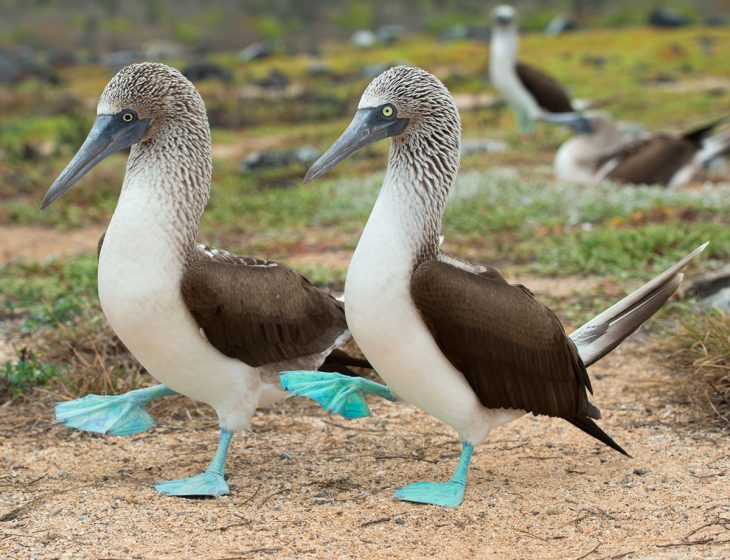Blue-Footed Booby (Sula nebouxii) takes great pride in their marvelous feet. During mating rituals, male birds normally show off their feet to prospective mates with a high-stepping strut. The Blue-Footed Booby is a marine bird in the family Sulidae, including ten long-winged seabird species. A booby’s coloration is strongly influenced by its immunological and health condition, so its blue feet are favored through sexual selection.
Therefore, the bluer the feet, the more attractive they are. A Blue-footed Boobie rarely vocalizes at sea except for occasional guttural braying sounds when squabbling over prey. Females and young nesting birds make hoarse quacking sounds (whistling). Also, Immature birds and females have a hoarse, ducklike call
The booby species are thought to take their name from the Spanish word (bobo), which means “stupid, clown, and Fool”. Because the blue-footed booby is clumsy on land and regarded as foolish for their apparent fearlessness of humans. Blue feet also indicate the current health condition of a booby, thus, the feet are rapid and honest indicators of a booby’s current level of nourishment.
These impressively beautiful feet birds live off the western coasts of Central and South America. The Galápagos Islands population includes about half of all breeding pairs of blue-footed boobies. The female bird is somewhat more significant than the male and can measure up to 90 cm long, have a wingspan of up to 1.5 m and weigh 1.5 kg. The female is slightly larger than the male. Similar to other boobies, the blue-foot nests on land at night.
Blue-Footed Booby is flown in search of seafood and may fly far out to sea, keeping an eye out for schools of small fish in cooperative groups such as sardines, anchovies, mackerel, and flying fish. These seabirds are exceptional divers, fold their long wings back around their streamlined bodies, plunge into the water from as high as 24 meters and swim underwater in search of their prey. Even so, they can also dive from a sitting position on the water’s surface. These birds hit the water around 97 km/h and have the ability to go to depths of 25 meters below the water’s surface.
Both sexes start breeding between 1 and 6 years old. The blue-footed booby usually lays 1 to 3 eggs at a time, and they’re very caring to their chicks and use their webbed feet to cover and keep them warm. Both males and females take turns incubating the eggs, and the incubation period falls between 41 and 45 days. Both male and female birds share parental responsibilities.
There is a variation of up to three years between females and males that fledged during the same season. The colony appears to have no shortage of nest sites, and both sexes are unlikely to postpone breeding because there is no potential partner. In most cases, boobies do not reproduce until they have mastered advanced foraging skills.
The male will provide food for the young and chicks feed off the regurgitated fish in the adult’s mouth. The boobies’ natural breeding habitats are tropical and subtropical islands of the Pacific Ocean. The blue-footed booby wings are brown in color, the neck and head are light browns with white streaks, and the belly, and underside are full white plumage. The blue-footed boobies have distinctive yellow color eyes with excellent binocular vision.
This is a strictly marine bird. Along the eastern Pacific’s rocky coasts, it breeds and rears young and does not require land. Blue-Footed Booby hunts singly, in pairs, or in larger flocks. Blue-footed boobies make raucous or polysyllabic grunts or shout and thin whistling noises and their ritual displays are also a form of communication, hence, mates can identify each other by their calls.
The Blue-Footed Booby population appears to have trouble in breeding and thus is slowly declining. The decline is feared to be long-term, but annual data collection is needed for a firm conclusion that this is not a normal fluctuation. Food problems may be the cause of an observed failure of the birds to even try to breed.
The Blue-footed Boobie nests on tropical islands in the eastern Pacific. Although thousands of seabirds live in Mexico’s Gulf of California, finding them in North America can be difficult. Compared to the Peruvian booby, its feet are grey, whereas its head and neck are whiter, and its wings have white spots.

